Recently, global news has filled my heart with sadness and anxiety. As a teacher of little kids, I try to maintain a light-hearted demeanor and a smile on my face. With adults, I joke about suppressing my feelings as I sing a song from the musical, “Book of Mormon.”
When you start to get confused because of thoughts in your head, don’t feel those feelings! Hold them in instead. Turn it off like a lightbulb! Just go click. It’s a cool little Mormon trick.
Sometimes that helps.
However, I can’t stop thinking of fear in the eyes of Syrian refugees. I lie awake at night angry over the helplessness we all feel when innocent people die in pointless bombings in random cities. I worry about fear breeding intolerance leading to hate resulting in rash laws and unlawful actions that ultimately shred the fabric of humanity. I stress about American politics, which presently seems to offer no viable option for making the world a better place. I wallow in my own personal uncertainty: so many unanswered questions and conflicting emotions related to a new life on a new continent and saying good-bye to a place and people we have loved for five years. In addition, India has been throwing us curve balls with confusing messages related to visas and taxes, creating a tense vibe among our staff.
So, yeah, I’ve been a little stressed lately. So stressed that I almost skipped a speech at school Friday by His Holiness the Dalai Lama, spiritual leader of the Tibetan people. As a support teacher, I didn’t have to accompany a class, so knowing the rest of the school would be at the speech, I almost stayed in my room to get some work done. Still, I knew I would regret missing this opportunity, so I headed to the gym.
Children in pre-kindergarten through second grade lined up outside to greet the Dalai Lama. Everyone agreed they wouldn’t benefit from sitting on the floor of the gym for his lengthy speech, but a receiving line was better than nothing. Many teachers had front-loaded his visit with wonderful lessons featuring his own quotes on kindness and compassion, so children were eager to see him. Inside the gym, we packed grades 3 through 12, teachers, and a few special guests from the top bleacher down to the floor, within a few feet of the small stage. Several teachers managed to secure invitations for their Tibetan maids, who stood at the front in traditional dress, nearly bursting with excitement. Each held a khata, a white scarf, which they would present to the Dalai Lama for blessing.
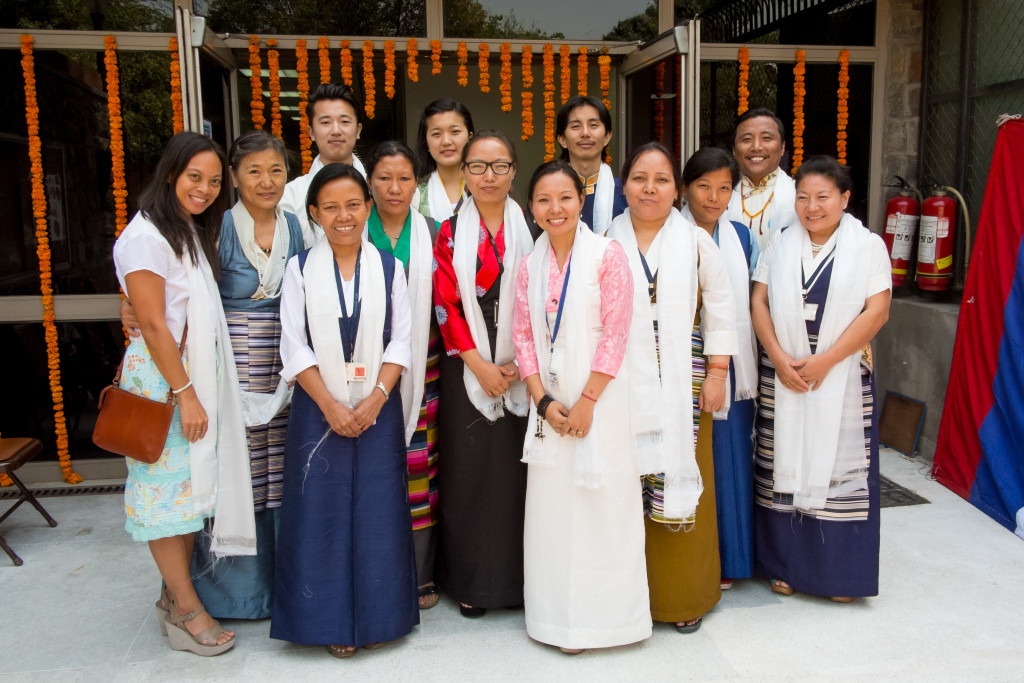 Photo courtesy of Tim Steadman
Photo courtesy of Tim Steadman
An overflow venue was set up for parents to watch the speech via live streaming video.
I traveled to Tibet in 2009, and in 2012 I visited Dharamsala in northern India, where the Dalai Lama lives in exile. I know his story. I empathize deeply with the Tibetan people. Although I’m not a Buddhist, I do embrace many Buddhist values. Yet I never could have anticipated the visceral impact of the Dalai Lama’s presence. I cried all day following his speech, but they were tears of gratefulness and hope. Even now, my eyes well up as I write this and my heart swells with happiness. I realize this sounds hokey and dramatic, and I don’t really understand it myself. One little octagenarian shifted my whole mindset and transformed my energy in less than two hours. How long will this last? Or maybe I should ask, how do I hold on to it? Or maybe even more importantly, how do I share it with others?
I’m still processing this myself, so I apologize in advance if my thoughts ramble.
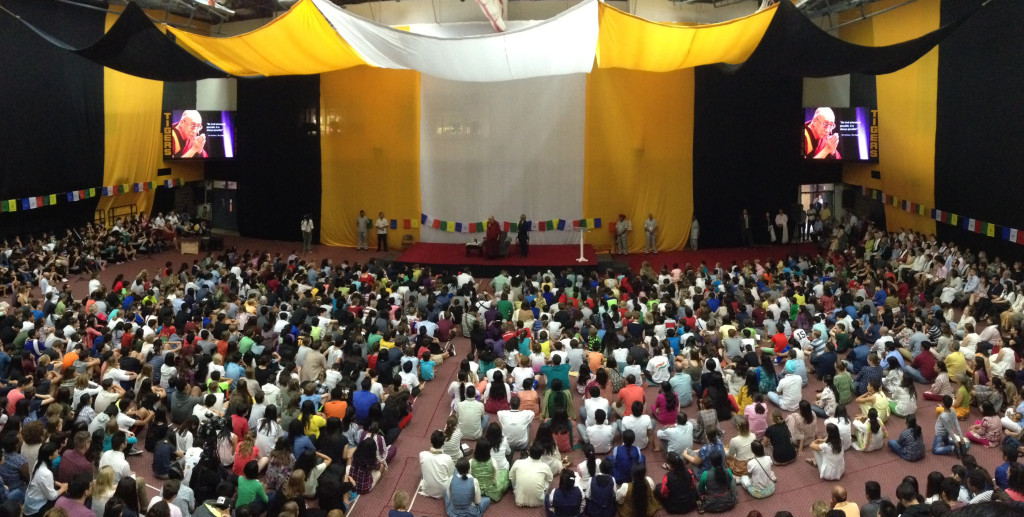 Photo courtesy of Eric Johnson
Photo courtesy of Eric Johnson
I entered the gym and sat with Tony in the bleachers. The usual rumble of chatter echoed off the walls, which were draped with black and gold, our school colors. The stage remained quiet, Tibetan prayer flags stretched across the backdrop and a comfy chair awaiting the arrival of His Holiness. After awhile, the head of Indian Studies got on the mic and encouraged us to quiet down and get our minds in a more meditative space. A hush fell over the gym, and even our youngest students remained calm until we were dismissed, more than 90 minutes later.
Soon, AES Director Paul Chmelik announced the Dalai Lama had arrived and was greeting the children outside. Later I learned why it took so long from that moment until the Dalai Lama entered the gym. I thought he would walk past the receiving line outside with a wave and a smile to the children, but he apparently paused and chatted, laughing, touching foreheads in a traditional Tibetan greeting, clasping their little faces in his hands, asking questions and chortling at the answers. “How old do you think I am?” 99! 75! (In fact, he’ll turn 81 this summer.)
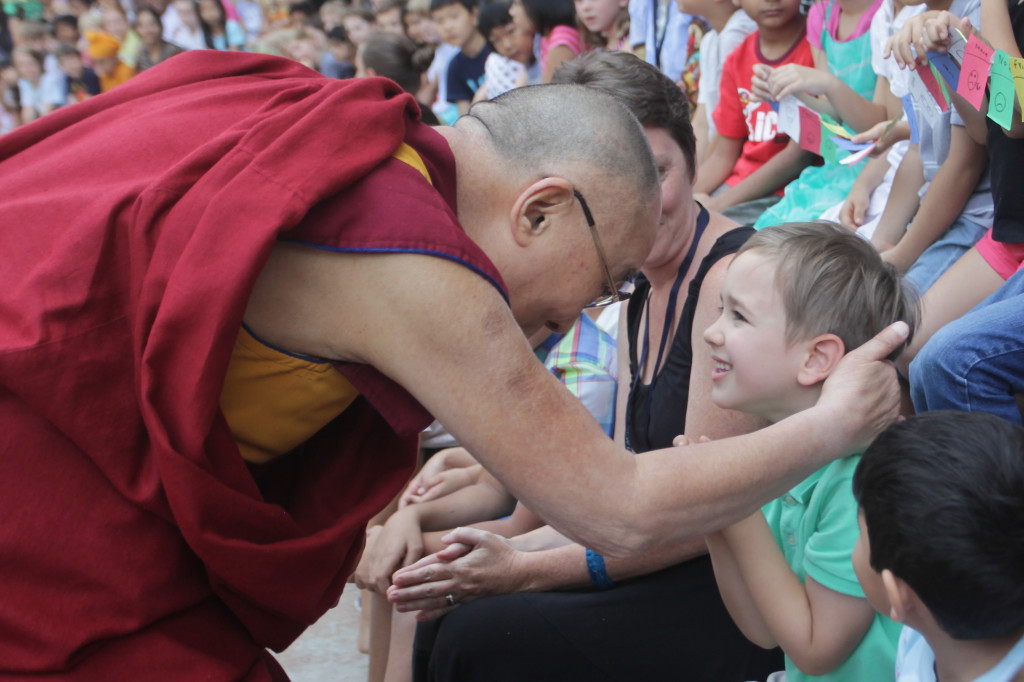 Photo courtesy of Eric Johnson
Photo courtesy of Eric Johnson
Greeting our friends, Scott White, ES assistant principal; Paul Johnson, HS principal; and Gary Coyle, director of technology.
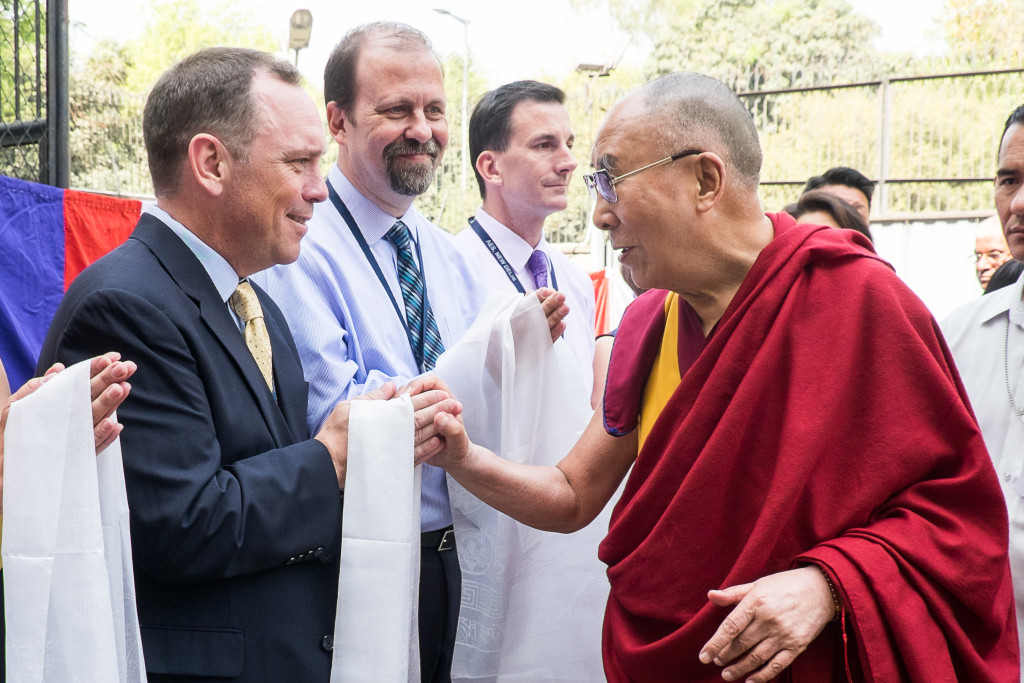 Photo courtesy of Alan Rubin
Photo courtesy of Alan Rubin
As the Dalai Lama passed through the doorway to the gym, the crowd stood. One of the Tibetan maids began to weep, her cries breaking the silence. He worked his way toward the stage, taking his time and engaging with those along the way, sharing a good laugh with a wheelchair-bound guest who had met him before, blessing the khatas and gently patting the bowed heads.
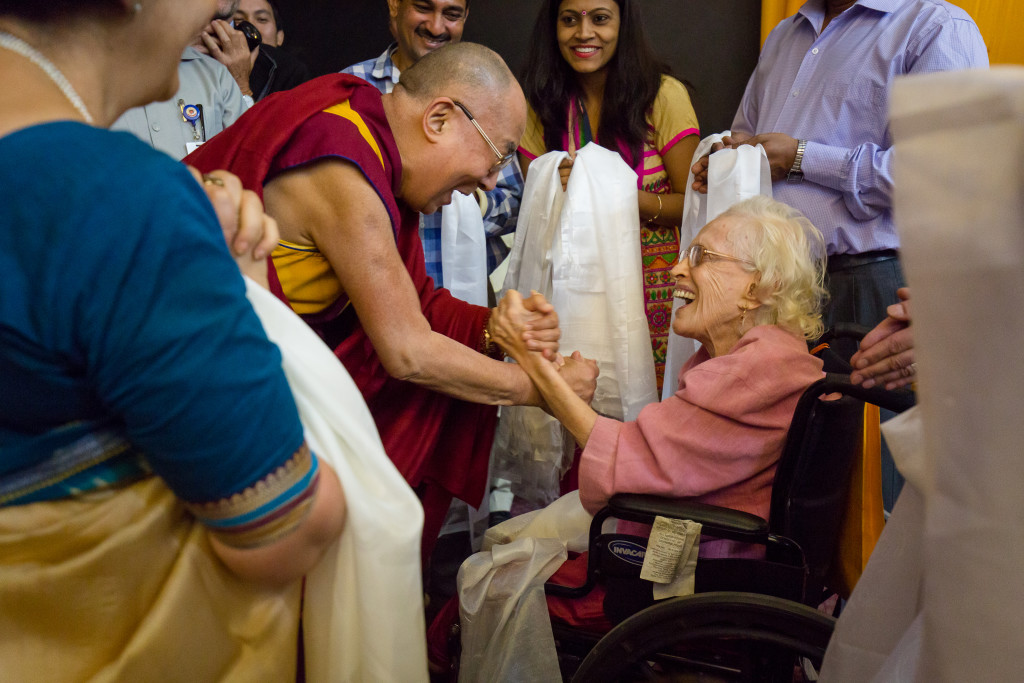
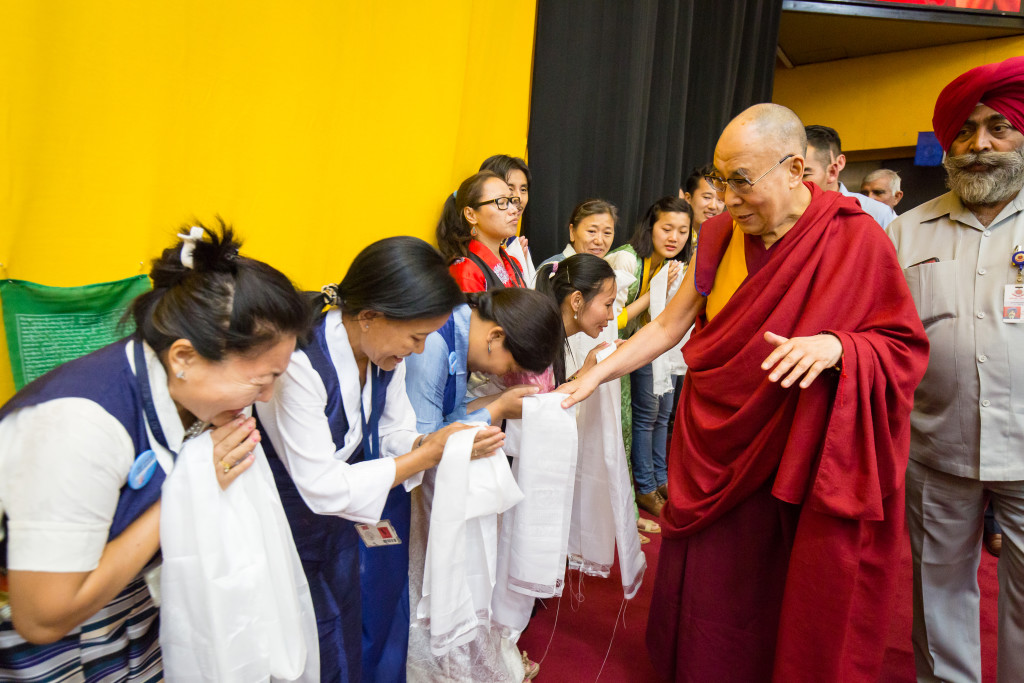 Photos courtesy of Mark Cowlin
Photos courtesy of Mark Cowlin
When he stepped onto the stage, he put his hands together in namaste and faced the crowd. Then he greeted the children on the floor, waggling his fingers and wobbling his head with a big grin. After an introduction by Dr. Chmelik, a sweet song by our elementary school choir, and a welcome from two high school seniors, the Dalai Lama addressed the audience – without notes and standing for the first 30 minutes of his speech.
Photos by Tim Steadman
“Indeed, I am very very happy come here, mixing with young brothers and sisters,” he said, citing two reasons. First, the past cannot be undone, but the future awaits, and these young people have the power to create a vision and work toward a world of compassion. His second reason for enjoying school visits, he said, was “little bit silly.”
“I am old person, old monk,” he said. “When I met some old people, I feel, oh, hmmm, you go first or me go first? When I meet these young people, I also feel little bit younger! More fresh, more fresh, like that!” And he laughed, a good hearty guffaw, at his own silliness.
With a translator standing by, he peppered his speech with funny anecdotes, often cracking himself up and pausing for a deep chuckle. He told of being a lazy student when he was young and tutored, along with his older brother, by a teacher who had two whips: a regular whip and a “yellow whip, a holy whip for holy student, Dalai Lama. I think holy pain is same as regular pain,” he laughed.
In a poignant moment, the Dalai Lama answered a student’s question about pets at his temple. He recalled having cared for many injured animals over the years – birds, dogs and cats, noting that compassion pays off with animals, too. They appreciate our affection and repay us in kind, he said, acting out the kneading gesture of a cat while making a purring sound. I loved that.
Between stories and laughter, the Dalai Lama repeatedly emphasized the importance of compassion in the world. He stressed the need for “a sense of concern for the well-being of humanity, a oneness for 7 billion human beings.” Compassion is intrinsic to human nature, he said, noting how human bodies function best when our minds are calm. It’s biological. As the world’s population grows and climate change impacts our natural resources, there is no other option than banding together through compassion. He pointed out that a person killed by a tiger or elephant is big news, but we hardly notice anymore when a person dies at the hand of another person. “This we have to change,” he said.
Addressing human rights violations around the world, he said it was useless to merely condemn them. He called on people to think about the causes of human rights violations and then “try to tackle the causes.”
What are those causes? Discrimination and intolerance seem to fuel emotions that lead to violence, he said. “I always think of myself as another human being, and that makes a close feeling (with others),” he explained. “If I’m a Buddhist monk, particularly Dalai Lama, His Holiness the Dalai Lama, then I am myself a little bit isolated from the audience. Out off 7 billion people, only one Dalai Lama. If I have too much emphasis on Dalai Lama, then I feel lonely. When I feel I am another human being, then we are brothers and sisters. … Too much importance on status, race, faith, nationality, rich or poor, educated or uneducated, influential or not influential. All problems are caused by these things. The only solution to those problems is to believe we are all fundamentally the same.”
When people feel connected and care about one another’s well-being, everyone benefits, he said. As social animals, human beings cannot survive without community. “The very source of our successful life, happy life, depends on the rest of the society. So too much self-centered attitude, narrow mindedness, selfish thinking … is actually destroying your own happiness.”
Pondering the power of religion to hurt and heal, the Dalai Lama pointed out that all major religions teach love, tolerance and forgiveness. It’s only natural that different philosophies arose around the world in the quest for those things, but the goal is the same. “There’s no grounds to discriminate or fight; we can develop respect when we realize it’s the same purpose,” he said. However, the culture surrounding religion is where real challenges arise. Social habits and beliefs instilled by religious institutions may cause more harm than good in today’s society, even if they originally served a useful purpose. He specifically named India’s caste system and the Islamic Sharia law as systems in need of change. To prove it can be done, he shared his own decision to sever the political arm of the Dalai Lama Institution and turn over power to democratically elected leaders in Tibet. “Almost a four-century-old practice is ended,” he said. “The reality of a time leads to changes in religious practice.”
The Dali Lama wrapped up his speech with a plea to teachers. Nurture deep connections with students, model compassion, and explicitly teach the values of kindness, tolerance and open-mindedness, he said. (Even his teacher with the whips grew to show great affection.)
So many resonating ideas surfaced during the Dalai Lama’s speech. He talked about relations with China (it’s getting better); science and religion (no reason for conflict); courage (honesty leads to self-confidence); study and self-reflection (there’s still so much to learn); optimism (“Power of truth is much stronger than power of gun.”); and his favorite places in the world (depends on the weather). Bottom line: Any change has to start with one person. Show compassion, receive compassion, and pay it forward.
What a role model for teachers and children, alike. This man is powerful enough to change a Buddhist institution, yet humble enough to purr like a cat and giggle with children. The future of an entire culture rests on his shoulders, yet he bubbles with optimism and hope. He can talk about brain science or world religions with confidence, yet he has no problem admitting “I don’t know.”
After watching the video of his speech – re-playing until I plucked meaning from occasionally scrambled word order or his heavy Tibetan accent – I came away with even more to think about. One thing the video couldn’t capture, though, was the energy in the room. It was unlike anything I have ever experienced. At the risk of sounding like a Buddhist charlatan, I can attest that the Dalai Lama’s aura washed over me in a deep and profound way. I’m clinging to it, committed to at least striving to embody the compassion he believes can save the world.
Accepting his AES swag.
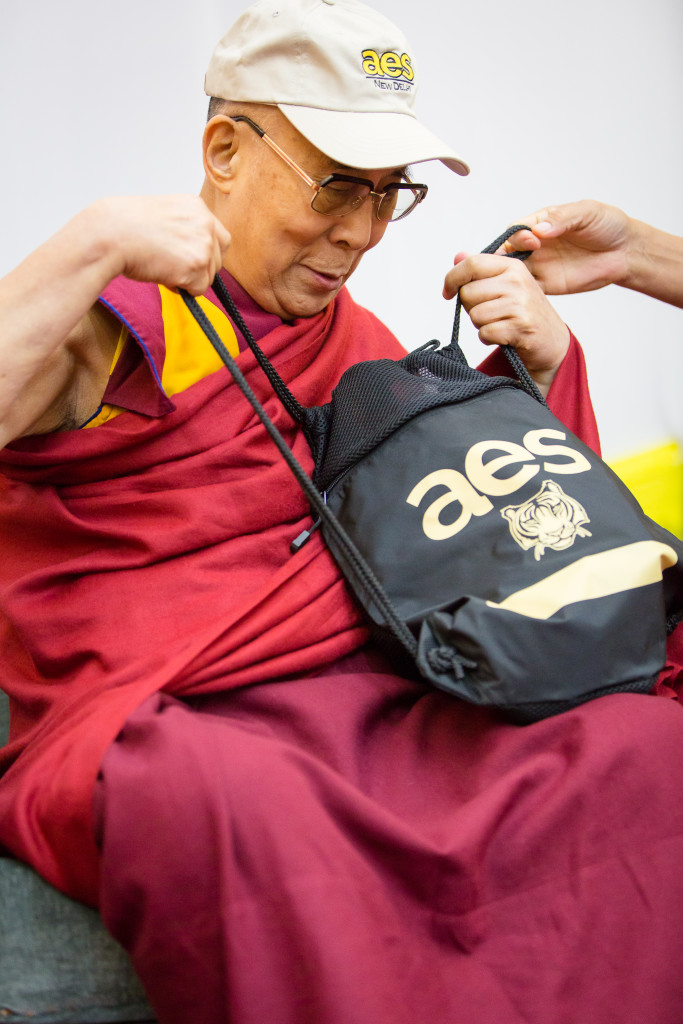 Photo courtesy of Mark Cowlin
Photo courtesy of Mark Cowlin
Still mingling on his way out.
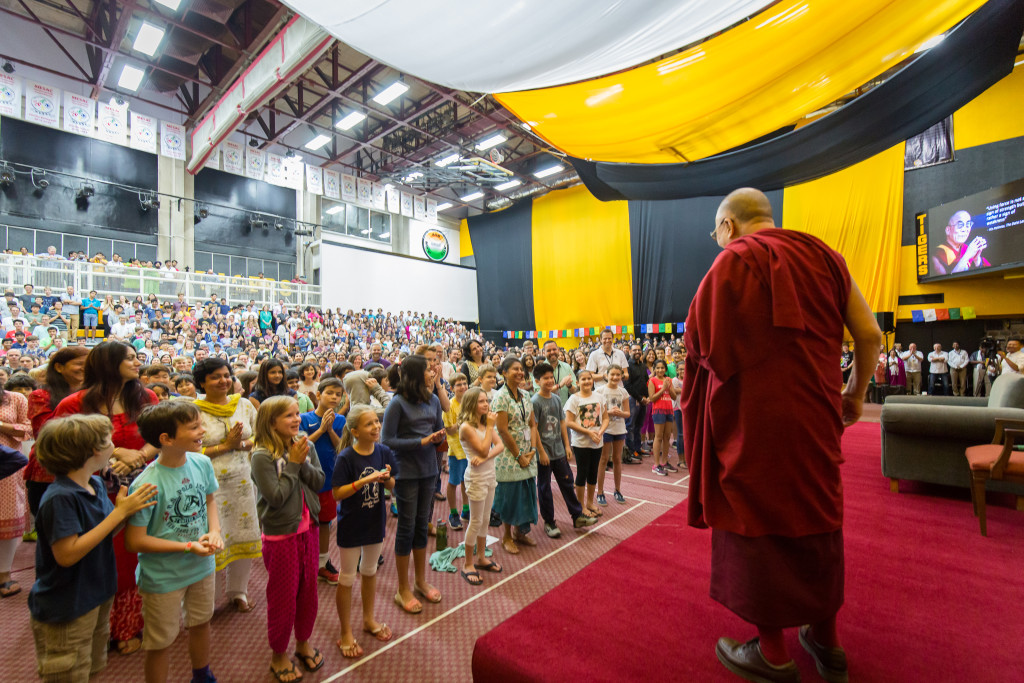
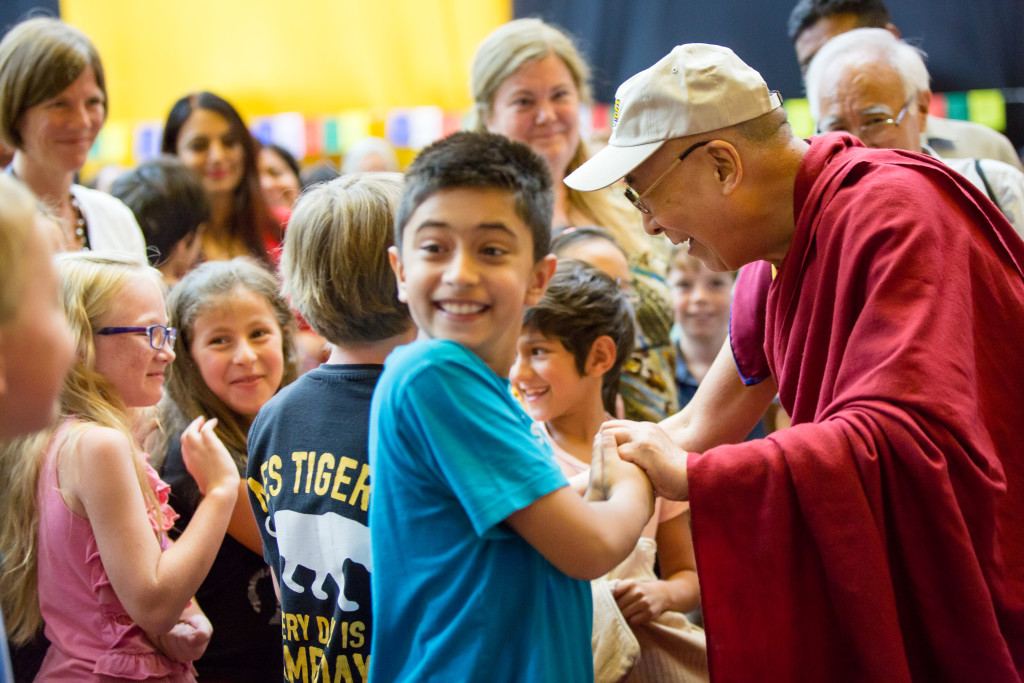 Photos courtesy of Mark Cowlin
Photos courtesy of Mark Cowlin
Here’s the video of His Holiness the Dalai Lama addressing the American Embassy School in New Delhi.

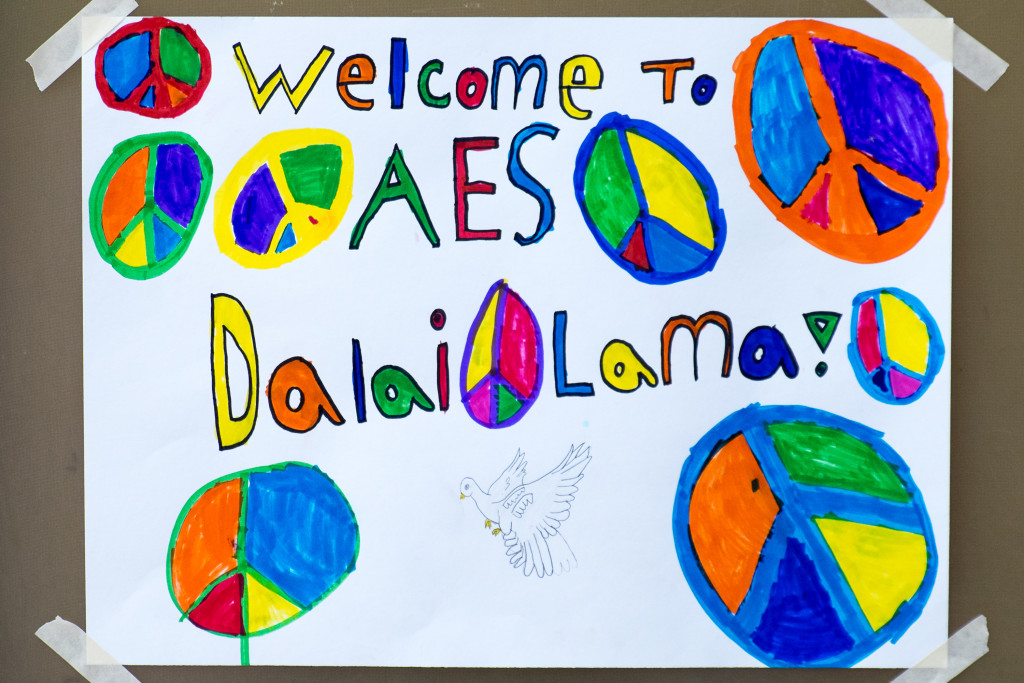
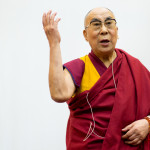
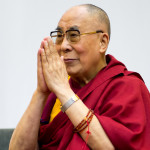
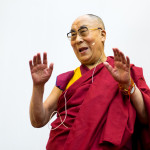
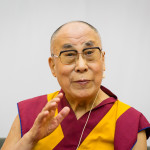
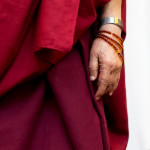
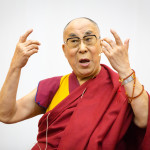
Powerful! Thanks Sharon! It also brought back so many memories of our trip together.
I know! I thought about you and Tibet so much on this day. xo
Thank you Sharon for sharing your amazing insights, subtle points of food for thought and inner experiences through a clear and concise expressive words of observation of the finer details down to His Holiness the Dalai Lama ‘s behaviour and Tibetan accent speech!
There is no doubt this master piece article, reminisce on the visit to American Embassy School New Delhi by His Holiness, on how to create a better world will shine throughout the coming generation of humankind for peace of mind and happier individual for a happier today and tomorrow.
Thank you Sharon for your invaluable contribution to world heritage that it will be!